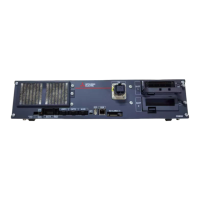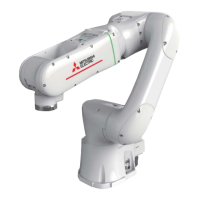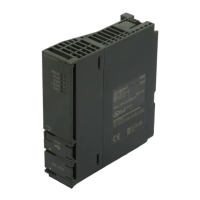1 Before use
1-3
(4) The Ethernet functions are described below.
Refer to the section "3. Description of functions" for details on each function.
1) Controller communication function
Data can be communicated with the robot controller via
Ethernet. (Program upload/download, status monitor, etc.)
Personal computer support software (optional) is available as
* Communication with up to
16 clients is possible.
Chapter 1 General
Chapter 2 General
Chapter 3.1
Chapter 4.1
2) Data link function
The value and position data can be linked between the
robot program and personal computer using MELFA-BASIC
V/VI language (OPEN/PRINT/INPUT command).
* By changing the
communication open
destination COM No.,
communication with
applications in up to 8 clients
Chapter 1 General
Chapter 2 General
Chapter 3.2
Chapter 4.1
Chapter 4.2.1
3) Real-time external control function
The position command data can be retrieved and operated at
the robot motion control cycle unit. Joint, XYZ or motor pulse
can be designated for the position data. It is also possible to
monitor the input/output signals or output the signals
simultaneously.
Control is started with the MXT command (MELFA-BASIC
* The user must create an
application program on the
personal computer side to
control the robot.
* Communication is carried
out one-on-one.
* UDP communication is
Chapter 1 General
Chapter 2 General
Chapter 3.3
Chapter 4.1
Chapter 4.2.2
4) Real-time monitoring function
The current position, speed at the tip of the arm, and other
measurements can be monitored by a PLC or computer in
real time at the robot motion control cycle unit.
* Use UDP. Chapter 1 General
Chapter 2 General
Chapter 3.4
5) SLMP connection
The server functions of SLMP communications can be used
from the robot controller. Data can be read from and written
to a robot controller device from a PLC or computer via the
* Supported by CR800
series only. Not supported
by CR750/CR751 series.
Chapter 1 General
Chapter 2 General
Chapter 3.5
Chapter 4.1
6) CC-Link IE Field Network Basic function
CC-Link IE Field Network Basic slave stations are supported,
and the signals and registers of robot controllers can be input
and output via regular communications (cyclic
correspondence) with a PLC, computer, or other master
* Supported by CR800
series only. Not supported
by CR750/CR751 series.
Chapter 1 General
Chapter 2 General
Chapter 3.6
Chapter 4.1
CAUTION
These functions can all be used simultaneously, but be aware that when the network handles
large loads, communications slow down and may not reflect real-time information.

